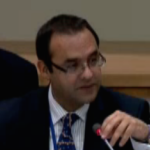High-level side event at the UN General Assembly, New York
27 September 2015, Conference Room 3 (CR3), 1:15-2:45 pm
At this critical juncture in the process of finalising how the Sustainable Development Goals (SDGs) will be measured, this important side event showed the importance of embedding a multidimensional measure of poverty within the new framework. Specifically the 20 eminent speakers stressed how a Global Multidimensional Poverty Index (MPI), as a core (tier one) indicator within the SDGs, can energise a coordinated, effective and multi-sectoral attack on poverty in all its dimensions (and thus help to measure Target 1.2 of the SDGs).
The event is organised by the Republic of Costa Rica and nearly 40 governments represented by the Multidimensional Poverty Peer Network (MPPN), a South-South network of senior government officials that is championing the use of multidimensional poverty measures alongside traditional income measures at both the national and global levels.
Download the agenda of the event
The speakers included:
H.E. Mr. Wu Hongbo, Under-Secretary-General for Economic and Social Affairs, United Nations who delivered a message from Ban Ki-moon, Secretary General of the United Nations.
Heads of state addressing the event, with excerpts from speeches:
H.E. Luis Guillermo Solís Rivera, President of Costa Rica
H.E. Mr. Tshering Tobgay, Prime Minister of Bhutan
“Bhutan’s national MPI is not only a measure, it is also a tool – a policy tool. We use it to inform our allocation of resources. It identifies people who are poor because of gaps in infrastructure and social services, even where people are not income poor, as in one of our remotest district.”
“I support the call to have a Global MPI as a Tier 1 indicator of the SDGs, and to support others to develop the use National MPIs.”
H.E.Mr. Juan Orlando Hernández, President of Honduras
H.E.Mr. Kenny Anthony, Prime Minister of Saint Lucia
“A Global MPI helps us know and understand poverty better, allows us to compare clearer, and gives us a stronger platform to remove the scourge of poverty from the human family.”
“The multidimensional poverty index finally gives us a tool to measure poverty across borders, across ideologies, across peoples. Let us redeem our brothers, sisters and every human being from the bondage of poverty. Now that we have proclaimed and committed to this hope, let us make it real for all humanity.”
The other distinguished speakers were:
H.E. Dr. Arsenio Balisacan, Socioeconomic Planning Secretary of the Philippines
H.E. Tatyana Orozco de la Cruz, Director of the Department for Social Prosperity of Colombia
H.E. Jeff Radebe, Minister in the Presidency for Planning, Monitoring and Evaluation, South Africa
H.E. Marcos Barraza Gómez, Minister of Social Development of Chile
H.E. Mr. Dang Huy Dong, Deputy Minister, Ministry of Planning and Investment of Vietnam
“Vietnam’s headline MPI will give visibility to our social progress. Vietnam is well-known for its high rate of economic growth and for its dramatic reduction in income poverty. In fact, our income poverty is very low now. So we need to turn to other basic needs and to social disparities. A headline national MPI will enable us to make the outcomes of our social policy as visible as our economic progress.”
H.E. Cecilia Vaca Jones, Minister Coordinator of Social Development of Ecuador
Dr. Savas Alpay, Chief Economist of the Islamic Development Bank
H.E. Mr Mikheil Janelidze, First Deputy Minister of Foreign Affairs of Georgia
H.E. Amadou Ba, Minister of Economy and Finance, Senegal
Tarek Nabil El Nabulsi, Director of Development and Social Policies Department, League of Arab States (a joint statement with Khalid Abu-Ismail, Chief Economic Policy Section, UN Economic and Social
Commission for Western Asia)
Dr. Ingolf Dietrich, Deputy Director-General, Head of the Special Unit of Post-2015 Agenda, Federal Ministry for Economic Cooperation and Development of Germany
H.E. Mrs. María Luisa Navarro, Deputy Minister for Multilateral Affairs and Cooperation of Panama
Mr. Noam Unger, Deputy Assistant for Policy, Planning and Learning, USAID of the United States
Dr. Gabriel Rivera Conde, Chief Strategic Projects, Office of the President of Mexico
“The multidimensional approach to poverty in Mexico has shown that such a measure is actually feasible and that it can become an essential tool for implementing and monitoring the evolution of all the multiple dimensions of poverty.”
L-R: H.E. Mr. Tshering Tobgay, Prime Minister of Bhutan; H.E. Mr. Juan Orlando Hernández, President of Honduras; H.E. Mr. Luis Guillermo Solís Rivera, President of Costa Rica
L-R: H.E. Marcos Barraza Gómez, Minister of Social Development of Chile; H.E. Dr. Arsenio Balisacan, Socioeconomic Planning Secretary of the Philippines; H.E. Tatyana Orozco de la Cruz, Director of the Department for Social Prosperity of Colombia
Photo credit: Zach Damberger





























Recent Comments